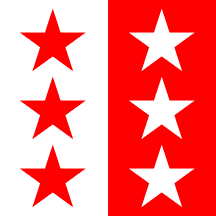 image by António Martins
image by António Martins

Last modified: 2025-07-12 by martin karner
Keywords: switzerland | valais | wallis | star | french | german |
Links: FOTW homepage |
search |
disclaimer and copyright |
write us |
mirrors
![[Flag of Valais/Wallis]](../images/c/ch-vs.gif) image by
António Martins/Tomislav Todorovic
image by
António Martins/Tomislav Todorovic
Description of the flag
Per pale argent and gules, thirteen mullets of five: in each field
four in pale and five on the palar line, all countercoloured.
Divided vertically into equal parts white (hoist) and red (fly). In
the white field and four red five-pointed stars arranged vertically.
In the red field are four white five-pointed stars arranged
vertically. A third row of five stars straddles the dividing line,
each star half red and half white opposite to the field colour. The
stars all have one point directed toward the top of the flag. They
are often incorrectly depicted fimbriated in black.
T.F. Mills, 4 November 1997
Symbolism of the flag
Red and white are the colours of the Bishop of Sion, the dominant
power in Valais until very recent times. The thirteen stars
represent the thirteen districts (Zehnden) of Valais, a number that
has remained constant since 1815 when Valais joined the Swiss
Confederation.
T.F. Mills, 4 November 1997
History of the flag
Valais, straddling the upper Rhone valley, was an important
territory to the ancient Romans due to the mountains passes linking
Italy to transalpine Europe. The monastery of St. Maurice, named for
a Roman Christian officer martyred in Valais (see history of Swiss flag), was founded in 390.
Valais was initially hostile to the Swiss Confederation but became
allied with it in 1403 after the Burgundian wars. The earliest known
war flag is the vertically divided red and white banner of the
Bishop of Sion, and has been documented at 1220. Valais consisted
of highly autonomous "Dixains" (Zehnden) owing allegiance to the
Bishop. Their own individual banners predominated until 1613 when
they united into a republic. The red and white flag of the republic
originally had six stars for its constituent Dixains. A seventh was
added in 1628, and in that year France, Savoy and Switzerland all
recognised Valais as a free republic.
In 1798 the French created the Helvetic Republic with Valais as one
of its new cantons. When the Helvetic Republic proved an unworkable
artificial creation, Napoleon mediated the Restoration of the Swiss
Confederation in 1803, but kept Valais out of the new polity in order
to guarantee French control of the strategic mountain passes. In
severing Valais from Switzerland, the five Dixains of lower Valais
were joined to it for a total of twelve stars in the flag (six in
each field). In 1810 France annexed Valais outright as the
Department of Simplon.
Since the Act of Mediation of 1803 was a Napoleonic creation, it
collapsed with him, and the Allies restored the pre-revolutionary
Confederation in 1815 with the addition of three new cantons
liberated from France. Valais thus rejoined Switzerland, and in the
process created a thirteenth Dixain (Conthey) out of parts of two
others (Martigny and Sion). The flag was accordingly altered to its
current form with thirteen stars in three rows.
T.F. Mills, 4 November 1997
Courtesy of Jos Poels the text of the decree (translated from the French) which established 12 stars for Valais, and the exact
date of the Constitution which set the number at 13 as they are today:
----------------------------------------------------------------------------------
LAW ON THE SEAL OF THE REPUBLIC
4 September 1802.
The parliament
("diete") of the Republic
After considering the findings of the
Commission on the Constitution regarding the seal to be adopted by the
Republic, (hereby) orders:
The colours of the Republic are white
and red; on this it will have twelve (12) stars (carrying 13 by the
Constitution of 12 May 1815) , and the legend SIGILLUM REIPUBLICAE VALLESIAE
. The seals of the different authorities will carry the name of their office
on the bottom.
Given in the Parliament at Sion, during their session of 4
September 1802.
The President of the Parliament: Stockalper
The
secretaries of the Parliament: Tousard d' Olbec, Augustini
The Council of
State agreed etc., signed and sealed, 7 September 1802.
The grand-bailiff of
the Republic; Augustini
For the Council of State:
The Secretary of
State: Tousard d' Olbec
----------------------------------------------------------------------------------
Christopher Southworth, 30 July 2005
The text of that law can also be found on the official website of the Valais, at
this page (French version, retrieved). [pdf sheet]
Pascal Vagnat, 1 August 2005
Quoting Whitney Smith (1975) ("Flags Through the Ages
and Across the World"), pp. 194–195:
"In 1795, however, the star
(particularly the five-pointed variety which Americans soon made their standard
form) was extremely rare: the city flag of Norden, Germany, the cantonal banner
of Valais, Switzerland, and a few military colors were virtually the only
examples of its usage in the world."
Ivan Sache, 17 July 2010
From 1498–1628 there were six stars in the arms.
António Martins, 25 October 1998
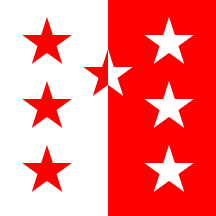 image by Tomislav Todorovic/António Martins
image by Tomislav Todorovic/António Martins
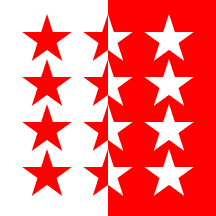 image by Tomislav Todorovic/António Martins
image by Tomislav Todorovic/António Martins
![[Colour Flag VS]](../images/c/ch-vs_56.gif) image
by Ole Andersen
image
by Ole Andersen
Simple rectangular cantonal flag, as shown in Kannik (1956) [So-called
colour flag (Farbenfahne in German)].
Ole Andersen, 4 August 2002
See also: STATE COLOURS in Dictionary of Vexillology
Flaggen, Knatterfahnen and Livery Colours |
![[Knatterfahnen]](../images/c/ch-vs_kf.gif)
|
Flaggen are vertically hoisted from a crossbar in the manner of gonfanon, in ratio of about 2:9, with a swallowtail that indents about 2 units. The chief, or hoist (square part) usually incorporates the design from the coat of arms – not from the flag. The fly part is always divided lengthwise, usually in a bicolour, triband or tricolour pattern (except Schwyz which is monocolour, and Glarus which has four stripes of unequal width). The colours chosen for the fly end are usually the main colours of the coat of arms, but the choice is not always straight forward.
Knatterfahnen are similar to Flaggen, but hoisted from the long side and have no swallow tail. They normally show the national, cantonal or communal flag in their chiefs.
Željko Heimer, 16 July 2000
See also: HANGING FLAG, VERTICALLY HOISTED FLAG, LIVERY COLOURS in Dictionary of Vexillology
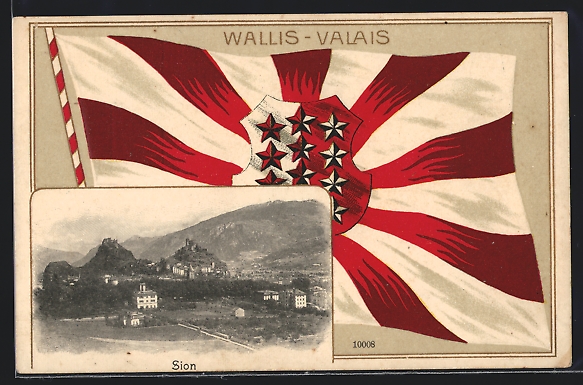
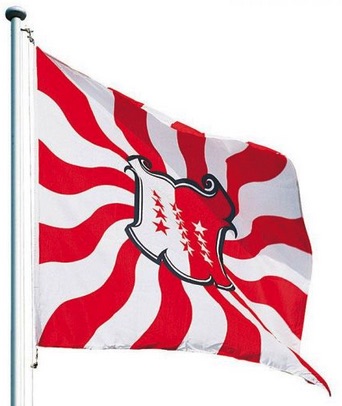 images located by Martin Karner
images located by Martin KarnerAt the beginning of the 20th century, flamed flags were still in use, with the white cross replaced by
a (baroque) shield in the centre of the flag. These decorative flags had been used until WWII and then
somewhat forgotten in preference of the current cantonal flags. [Today they are being
produced again, see right image]
Pascal Gross, 30 June 2002
See also:
logo.jpg) image located by Martin Karner (8 May 2024)
image located by Martin Karner (8 May 2024)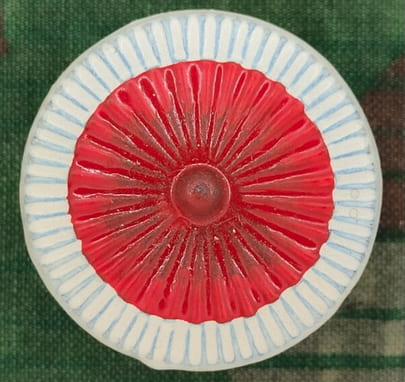 image located by Martin Karner
image located by Martin KarnerCockade for the cantonal troops' headgear (regulation from 1898, size: ca. 35 mm, reverse side).
Martin Karner, 14 March 2025
See also: Cockades (Swiss Army)